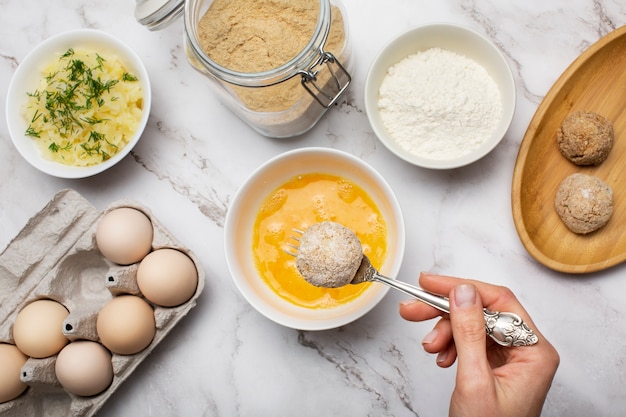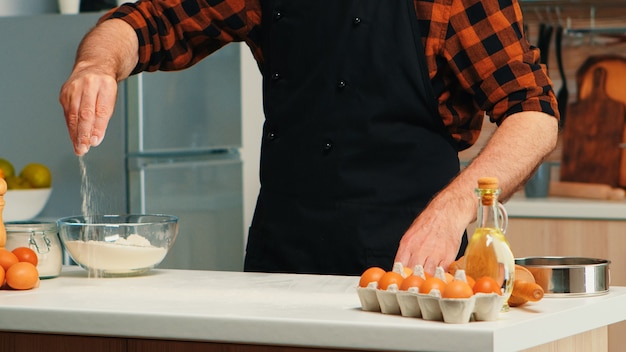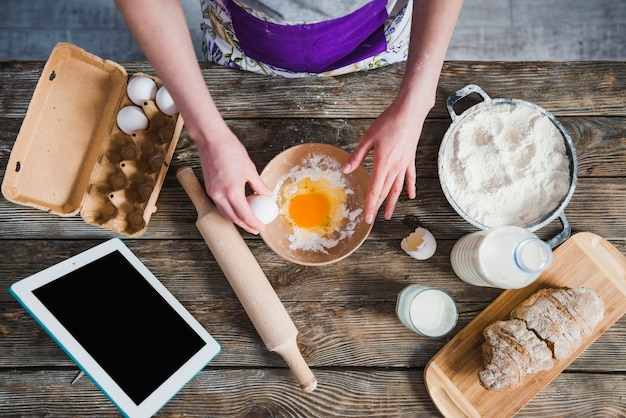I've always considered myself a decent cook, but boiled eggs have always been my Achilles heel. The struggle is real, right? The shell stubbornly clinging, the egg white getting torn, and the overall frustration just ruining your breakfast. But, over time, I've discovered the secrets to achieving perfectly peeled, consistently cooked eggs, and today I’m sharing them with you! It’s time to reclaim your morning and make those boiled eggs work for you.
This isn’t just about getting a smooth peel, though that is a critical part of it. We’re talking about a whole process, from the moment you pick up the eggs from the grocery store to that satisfying moment of slicing the perfectly cooked, creamy yolk. Get ready to conquer the boiled egg, one step at a time!
Part 1: The Perfect Boil: A Foundation for Success

choosing the right eggs: A Matter of Age
This might sound obvious, but trust me, it's crucial. You can't just grab any old eggs and expect perfection. The age of your eggs plays a big role in how easily they peel. Older eggs, about a week or more old, are the way to go. The air pocket inside the egg gets bigger as it ages, making the shell more porous and easier to peel. Just make sure the eggs aren’t so old that the yolk starts to get dry and rubbery. That’s not the texture we’re aiming for!
The Art of the Simmer: Mastering the Gentle Heat
I'm a firm believer in simmering for the perfect boiled egg. It's about gentle heat, creating a consistent cook and a beautifully soft yolk. Here’s my tried-and-true method:
- Start with cold water: Place your eggs in a saucepan and cover them with cold water. The water should be at least an inch above the eggs. This ensures even heating and prevents cracking.
- Bring to a gentle simmer: Turn the heat up until the water begins to bubble gently. We’re not looking for a roaring boil, but a gentle simmering. Think of it like a low hum, not a loud roar.
- Set your timer: Once the water is simmering, cover the pan and set a timer based on your desired level of doneness. I've included a helpful chart to guide you.
The Plunging Method: For Firmer Yolks
If you prefer a firmer yolk, the plunging method might be your go-to. This method involves bringing a pot of water to a full boil, then carefully lowering the eggs into the boiling water. It creates a faster cooking time, leading to a more firm texture. But be careful, this method can sometimes lead to more cracked eggs, so be gentle!
Boiling Time Chart: Finding Your Perfect Egg
| Cooking Time | Result | Perfect For |
|---|---|---|
| 3 minutes | Very runny yolk | deviled eggs, runny yolk enthusiasts |
| 4 minutes | Slightly runny yolk | Salads, where the yolk adds creaminess |
| 5-6 minutes | Creamy yolk | Versatile, good for sandwiches and salads |
| 7-8 minutes | Firm yolk | Sandwiches, where you want a less runny yolk |
| 9-10 minutes | Very firm yolk | Hard-boiled, for a solid, sturdy egg |
Experiment and find your ideal texture! Remember, there's no right or wrong, it's all about personal preference.
Part 2: The Peeling Process: From Shell to Smoothness

This is where the magic happens. The peeling process is the ultimate test of your boiled egg skills. But don't worry, with the right techniques, you'll be peeling like a pro in no time. The key is to create a little air pocket under the shell, loosening it up for a stress-free peel.
The Cold Water Trick: A Shock to the System
As soon as the timer goes off, drain the hot water and immediately plunge your eggs into a bowl of ice water. This sudden temperature change helps the shell contract away from the egg white, making it much easier to peel. Let the eggs chill for at least 10 minutes to ensure the shock does its job.
The Gentle Tap: Creating a Starting Point
Once the eggs are chilled, gently tap the larger end of the egg on a hard surface like your kitchen counter. This will create a small crack in the shell, giving you a starting point for peeling. Be gentle! A few light taps are all you need, not a full-blown assault on the egg.
The Peel-Off Technique: Slow and Steady Wins the Race
Now comes the peeling part. Start by gently peeling away a small portion of the shell at the crack you made. Use your thumb and forefinger to gently lift up the shell, and then peel away a small piece. The trick is to be patient and peel slowly, letting your fingers guide the shell away from the egg white. Avoid trying to rip off big chunks of shell; this can tear the egg white and make the peeling messy.
The Helpful Tool: A Little Assistance for Stubborn Eggs
If you find yourself struggling with a stubborn egg, don't hesitate to enlist a little help. I find that a teaspoon or a small butter knife can work wonders for getting under the shell and gently lifting it away from the egg white. Just be cautious not to dig too deep and damage the egg. A gentle touch is key!
Part 3: Variations and Ideas: Beyond the Basic Boil

Now that you've mastered the basic technique, let’s explore some creative ways to make your boiled eggs more exciting!
The marbled egg: A Dash of Colourful Fun
Who says boiled eggs have to be plain white? Add a touch of whimsy with marbled eggs! Simply add a few drops of food colouring to the water before adding the eggs. Start with a pale colour like yellow or pink, then add a few drops of darker colours like red or blue for a more dramatic effect. The colours will seep into the eggshell, creating a beautiful marbled pattern. These are fun for parties or just adding a bit of joy to your breakfast.
The Curried Egg: A Warm, Aromatic Twist
For a flavourful twist, try adding a teaspoon of curry powder to the boiling water. The curry powder infuses the egg with a subtle, aromatic flavour. Serve these eggs with a dollop of yogurt or a sprinkle of chopped coriander for an extra punch of flavour. They’re a great option for a light and flavorful lunch.
The Pickled Egg: Tangy and Unique
Looking for a tangy and unique treat? Try pickling your boiled eggs! It adds a vibrant burst of flavour and creates a shelf-stable snack, perfect for picnics or lunch boxes. To pickle your eggs, combine vinegar, water, sugar, salt, and your favourite spices in a jar. Add the boiled eggs and let them soak in the brine for at least 24 hours. The longer they soak, the more intense the flavour.
The Deviled Egg: A Classic Appetizer
No boiled egg collection is complete without the classic deviled egg. This is a crowd-pleaser, and a perfect appetizer for parties or potlucks. To make deviled eggs, hard-boil some eggs, peel them, and slice them in half lengthwise. Scoop out the yolk and mash it together with mayonnaise, mustard, chopped gherkins, and any other seasonings you like. Pipe the mixture back into the egg whites, garnish with paprika or chopped chives, and enjoy!
Part 4: Beyond the Boil: Exploring Other Egg Cooking Methods
Boiling is a great starting point, but there's a whole world of egg cooking methods to explore.
Poaching: A Luxurious and Elegant Choice
poached eggs are a perfect way to elevate your breakfast or brunch. They look elegant and are surprisingly easy to master. The key is gentle heat and avoiding too much stirring of the water. This allows the egg white to set without becoming rubbery. To poach an egg, gently crack it into a small ramekin. Bring a pot of water to a simmer and add a splash of vinegar. The vinegar helps the egg whites to coagulate more quickly and keep the egg together. Gently swirl the water to create a whirlpool, then carefully slip the egg into the center. Cook for 3-4 minutes, or until the white is set and the yolk is still runny.
Baking: A Convenient and Hands-Off Approach
Baking eggs is a great way to cook them when you're short on time or need to prepare multiple eggs at once. Simply crack an egg into a ramekin and bake it in a preheated oven at 350 degrees fahrenheit for about 15 minutes. The result is a perfectly cooked egg with a fluffy texture.
Frying: A Classic Breakfast Staple
Fried eggs are a classic breakfast staple, and a quick way to cook eggs. The key to achieving a crispy, golden-brown fried egg is using a good quality non-stick pan and cooking over medium heat. To fry an egg, heat a small amount of oil in a non-stick pan over medium heat. Crack an egg into the pan and cook it for about 3 minutes, or until the white is set and the yolk is cooked to your liking. For a runny yolk, cook it for less time, and for a firmer yolk, cook it for longer.
Part 5: Egg-cellent Storage: Keeping Your Eggs Fresh
Once you've cooked your perfect eggs, it's important to store them properly to maintain their freshness and quality. hard-boiled eggs can be stored in the refrigerator for up to a week, but it's best to eat them within a few days for the best flavour and texture.
To prevent the yolk from turning green, store the eggs in a bowl of cold water. The water helps to keep the eggs fresh and prevents the yolk from oxidizing.
Part 6: Beyond the Kitchen: The Versatility of Boiled Eggs
Boiled eggs aren't just for breakfast. They're incredibly versatile and can be enjoyed in countless ways.
Snack Attack: A Quick and Nutritious Bite
A hard-boiled egg is a perfect on-the-go snack. It’s a great source of protein and nutrients, and it's easy to pack and take with you anywhere.
Salads: Adding Texture and Flavor
Boiled eggs add texture and flavour to any salad. They complement leafy greens, crunchy vegetables, and protein-rich toppings like grilled chicken or chickpeas.
Sandwiches: A Classic Filling
Sliced boiled eggs are a classic sandwich filling. They add a creamy richness and a satisfying crunch. Pair them with other toppings like lettuce, tomato, and cheese for a delicious and hearty sandwich.
Breakfast: Starting the Day with Protein
Start your day with a protein-packed breakfast by adding boiled eggs to your favourite morning meal. Slice them up and add them to oatmeal, toast, or a smoothie for a nutritious and satisfying breakfast.
Part 7: The Art of Presentation: Making Your Eggs Stand Out
Even the simplest dishes deserve a bit of presentation flair. Here’s how to make your boiled eggs look as good as they taste.
Get Creative: Beyond the Basic Shape
Instead of the usual plain white boiled egg, get creative with your presentation. You can use cookie cutters to shape the eggs, or slice them into decorative patterns. For a festive touch, use food colouring to dye the eggs different shades and colours.
Garnish with Style: Adding a Touch of Elegance
Don't forget the garnish! A sprinkle of fresh herbs like chives or parsley, a dash of paprika, or a drizzle of olive oil can elevate a simple boiled egg to a beautiful and delicious centerpiece.
Part 8: FAQs: Answering Your Boiled Egg Questions
Here are some frequently asked questions about boiled eggs, to help you become a true egg expert.
Why do my boiled eggs have green yolks?
The green yolk is a sign of overcooking or prolonged exposure to heat. It’s caused by a chemical reaction between the sulfur in the egg white and the iron in the yolk. To prevent green yolks, cook the eggs for a shorter amount of time and cool them down quickly in ice water.
Why do my boiled eggs crack when I cook them?
Eggs can crack during cooking due to a sudden change in temperature or if the eggs are too old. To prevent cracking, add the eggs to cold water and bring the water to a simmer gently. Avoid overcrowding the pan, as this can also lead to cracking.
What is the best way to store boiled eggs?
Hard-boiled eggs can be stored in the refrigerator for up to a week, but it's best to eat them within a few days for the best flavour and texture. To prevent the yolk from turning green, store them in a bowl of cold water.
What are some creative ways to use boiled eggs?
Boiled eggs are incredibly versatile! They can be enjoyed as a snack, added to salads and sandwiches, or used as a base for delicious appetizers like deviled eggs.
How do I know if a boiled egg is cooked?
You can test the doneness of a boiled egg by gently spinning it on a flat surface. If it spins smoothly, it is likely cooked. If it wobbles or is unstable, it needs more cooking time.
With these tips and tricks, you’ll be able to master the art of the perfect boiled egg and enjoy them in all their delicious glory. From simple snacks to gourmet dishes, the boiled egg is a culinary treasure that deserves a place in every kitchen.
Everyone is watching

Corn on the Cob: The Ultimate Guide to Perfectly Cooked Ears
Healthy MealsAh, corn on the cob. Just the name evokes images of sunny days, barbecues, and that sweet, juicy flavour that ...

Perfect Pork Roast Oven Cooking Time: A Guide to Delicious Results
Healthy MealsThere's something truly satisfying about a perfectly roasted pork. The aroma alone is enough to make your mout...

Ham Cooking Time: How Long to Bake, Smoke, or Boil a Delicious Ham
Healthy MealsAh, ham. It's a classic, isn't it? A real crowd-pleaser, especially around holidays. And when done right, it'...

Scallops: The Ultimate Guide to Perfect Cooking
Healthy MealsAh, scallops. Those delicate, sweet, and utterly delicious morsels of the sea. They hold a special place in my...

Spaghetti Squash: The Ultimate Guide to Cooking and Serving
Healthy MealsRemember that time you saw spaghetti squash at the supermarket, looking all bumpy and strange, and thought, "W...
